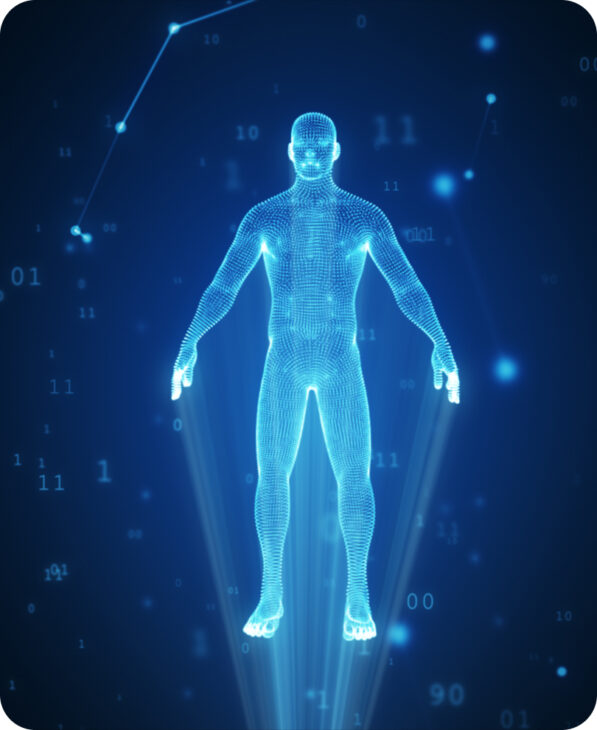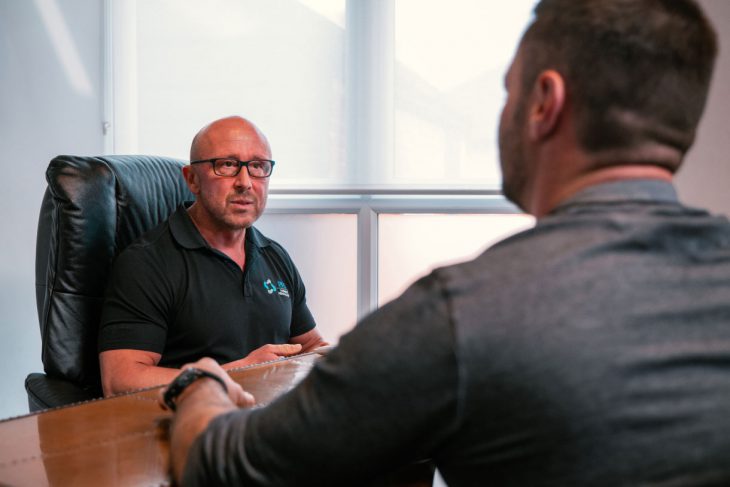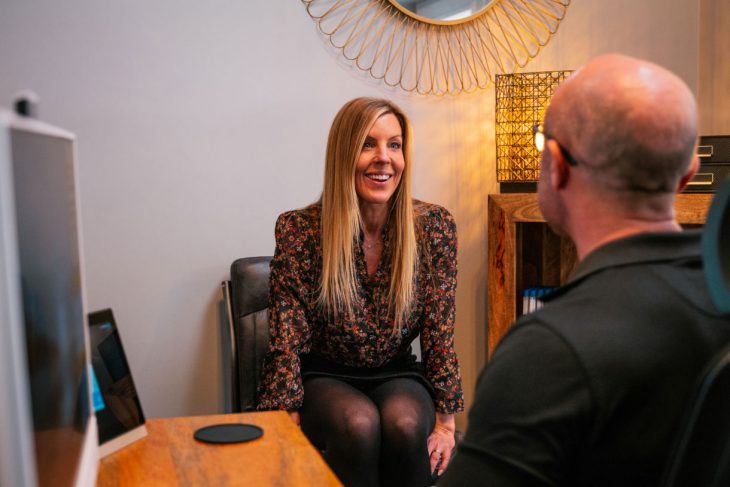Low Testosterone to Normality:
Arrange Your Blood Test
The typical longstanding symptoms of low testosterone can include:
- Low mood / anxiety / depersonalisation
- Brain fog
- Lethargy
- Low libido
- Erectile dysfunction
- Loss of lean muscle mass, increase adiposity, loss of bone mineral density etc.
If you are concerned that you might have Testosterone Deficiency, you will need diagnostic blood tests and subsequent discussion with a medical doctor.
The first test should be a comprehensive blood work up, as explained in the article Testosterone – Which Blood Test Do I Need & Why? Both the TRT COMPLETE and TRT COMPLETE PLUS blood panels are comprehensive blood screens that help us to identify causation, look at possible reversible factors and help eliminate any contraindications to therapy.
You will need two blood tests to demonstrate chronicity. If potential areas for improvement are identified in the first test, attempt to correct them before the second confirmatory test. If your second reading is low and you are willing to put the work in, and have realistic expectations, Testosterone Replacement Therapy (TRT) can be life changing.
Aways remember that Testosterone Deficiency should be a diagnosis of exclusion. Look to address stress, sleep hygiene, nutrition, and physical activity BEFORE considering committing to TRT, because in order to feel the benefits of healthy male androgen levels, you will need to address all of these aspects of your health.
Ideally, look to NOT need TRT. It is an involved process, as well as being a commitment of your time, effort and finances. To help you with this, we have written the following articles:
Pre-TRT Concerns:
The premise behind TRT is to normalise male androgen levels to help facilitate normal physiological processes, for both physical and psychological well-being. Patients typically want reversal of their negative presenting symptoms, not fully appreciating that their low testosterone is usually the end result of a cascade of events over time that also need addressing. No one leads the perfect life, but we must always strive to be better, effort equals reward.
One of the limitations of all medications is that their effect is more fixed than reactive. Physiology is complex, constantly adjusting to both internal and external factors to try and maintain homeostasis. After your dose has been carefully titrated according to affect, patients are always under active follow-up, which includes monitoring both qualitative symptoms and quantitative markers to ensure continued safe and effective prescribing of their TRT.
Infertility:
Traditional testosterone monotherapy suppresses the release of Lutenising Hormone (LH) and Follicle Stimulating Hormone (FSH) from the pituitary gland, negatively impacting spermatogenesis (sperm production), which can result in infertility.
We routinely use HCG, which mimics LH, as part of our gold standard TRT regime, as it helps to maintain both testicular and brain function. We have lost count of the number of pregnancies our patients have achieved on a therapy that typically cites infertility as the main reason NOT to prescribe TRT in younger men. The benefits of HCG extend further than maintaining fertility however, something discussed further in the article The Benefits of Using HCG with TRT.
Male Pattern Baldness:
Rest assured; this is primarily genetic in origin. We strongly advise against using Finasteride, a 5-alpha reductase inhibitor, as it blocks the conversion of testosterone to dihydrotestosterone, a necessary hormone for optimal well-being. Disturbing side effects include sexual dysfunction, primarily as a result of low DHT, but also troublesome anxiety and low libido, due to low DHT and a decrease in GABA.
As a private medical clinic specialising in the diagnosis of and treatment of Testosterone Deficiency, it would be in our interests to promote Finasteride if the benefits outweighed the risks. However we don’t, because in our experience, Post Finasteride Syndrome (PFS) is very real and can be very debilitating, something discussed in The Devastating Effects of Finasteride: Post-Finasteride Syndrome (PFS). The only people that state otherwise either do not understand physiology, or they have a financial incentive to recommend its use.
Gynecomastia:
Gynecomastia is the abnormal breast tissue development in males. It is well understood that the primary drivers of breast growth in females are oestradiol, prolactin, progesterone, and IGF-1.
Reassuringly, Gynecomastia is a rare occurrence in TRT patients, especially with a well-balanced TRT protocol. Whilst benign in nature, it is obviously unwanted and can be understandably distressing due to the perceived unsightly nature of the condition. In TRT, it is typically due to raised oestradiol which is excitatory to breast tissue development. By direct comparison both testosterone and DHT are inhibitory. If Prolactin is also elevated, this is typically because of oestradiol inhibiting prolactin-inhibitory-hormone (aka dopamine) within the arcuate nucleus of the hypothalamus. Raised oestradiol also has a direct stimulatory effect on the pituitary gland.
Some men do appear to be predisposed to developing gynecomastia. Androgenic Anabolic Steroid users who had past issues appear to be sensitised to this issue. However, try not to panic as the permanent fibrous stage of gynaecomastia typically takes months to develop. If your TRT protocol needs adjusting to optimise your testosterone to oestradiol ratio, please adhere to our clinical advice and recommendations. Medical management entails the use of Raloxifene, a Selective Estrogen Receptor Modulator (SERM), which appears to be more effective in managing fibrous gynecomastia than Tamoxifen, another commonly off-license prescribed SERM. However, sometimes surgery is the only definitive solution.
Acne:
Whilst traditionally thought to be DHT related, we have found through clinical practice that excess oestradiol seems more causative, as optimising the ratio of testosterone to oestradiol appears to resolve the issue in our cohort of patients. Acne sometimes occurs in the first few weeks due to initial hormone fluctuations, it typically settles as stable hormone levels are achieved.
To minimise the risk of acne, ensure that you are well-hydrated at all times, and avoid chocolate and dairy in your diet. Also, use a soap or shower gel that does not contain sodium lauryl ether sulfate, as this can clog up your sebaceous glands increasing the risk of developing acne.
Cardiovascular Risk:
This is a complex subject and addressed in the article Dispelling The Myths: TRT & Cardiovascular Health.
The premise behind TRT is normalisation of male androgen levels to help facilitate physiology (how your body functions).
According to the Society for Endocrinology:
“Although testosterone treatment increases the risk of erythrocytosis, the available randomised controlled trials and observational data have failed to reveal any consistent association (positive or negative) between testosterone treatment and cardiovascular or cerebrovascular events.”
This is why we monitor both Blood Pressure and Haematocrit as a matter of routine in all our TRT patients.
Prostate Concerns:
Preventing prostate disease should be of primary importance to all men, not just men on TRT. We routinely screen the prostate via regular Prostate Specific Antigen (PSA) blood tests, alongside a yearly prostate check via digital rectal examination in all men over 40 years old.
It would make little sense that healthy hormone levels would be causative to cancers, as hormones are essentially chemical messengers that help facilitate the function of their target hormones. It makes more sense that abnormal hormone levels would not be beneficial. This subject is discussed further in the article Dispelling the Myths: Prostate Cancer & Testosterone Replacement Therapy (TRT).
Daily Injections:
As much as we can attempt to reassure you, until you have had your first injections in clinic you won’t fully appreciate how little of a big deal it really is.
As apprehensive as you may be walking into the consulting room, shoulders always drop after the first injections have been administered, with an audible sigh of relief. It’s just a microdose of testosterone and hCG into the subcutaneous tissue using a tiny insulin needle, and is essentially painless. Rest assured that the process quickly becomes part of your daily morning routine, much like brushing your teeth. Injections typically take less than two minutes to prepare and administer, the time it takes to boil the kettle for your morning coffee!
TRT should be something that you simply do, a part of your daily routine, there should be no additional expense of psychological angst. Many of our patients at their annual review back in clinic state they don’t even think about it any more, they are busy concentrating on life!
Starting TRT:
If you are a candidate for therapy, our gold standard TRT is daily subcutaneous Testosterone Cypionate and Human Chorionic Gonadotropin (hCG) injections. In our professional opinion, this is the most effective method of achieving stable male androgen levels and an improvement in overall sense of well-being.
Our prescribing rationale is described in the article – Microdosing TRT – The Future of Testosterone Replacement Therapy. HCG is used to help preserve testicular function and fertility, amongst other reasons, something discussed in the article The Benefits of Using HCG with TRT.
Day 1:
Your 90-minute New Patient TRT Consultation includes taking a thorough history, performing a physical examination, having a full benefits and risks discussion, and then coming to a joint confirmation that TRT is in your best interests. Finally, a signed consent to treatment is obtained before you commence therapy. You can then start TRT.
Days 2-14:
You may notice a sudden improvement in your mood (or a temporary heightened anxious state). If it is pleasant – enjoy it, if its negative – relax as it’s just a temporary effect from the peaks and troughs of starting HCG. The drug levels need to stabilise before you can be more objective about your subjective experience.
By the very nature of starting new medication, it will cause a spike in that drug level, often coined ‘peaks’, with a subsequent drop in levels, called a ‘trough’, as the drug is metabolised. This is 100% a temporary effect. Sometimes you may feel nothing at all, but rest assured that this does not mean the medication isn’t “working”, it just means that you haven’t felt the initial drug effect.
Weeks 2-8:
By now you should be feeling more “stable”. Hopefully incrementally better, but disappointingly sometimes worse. If you feel worse, this is typically due to your testosterone level being either too high or too low. Your oestradiol may also be rising disproportionately high compared to testosterone, causing an element of anxiety.
This process is a rite of passage, you can sometimes feel worse before feeling better as we continue to carefully titrate your dose according to affect, the process of achieving healthy male androgen levels can take some time. This educational video may be informative over this period – Your TRT Journey – Feeling Worse Before Feeling Better.
Following repeat blood tests four weeks into treatment, you will then be reviewed at Week 5 to assess your body’s initial response to treatment, alongside your qualitative sense of well-being. Your dose may need to be adjusted before stable levels are achieved. The premise behind this review is obviously to check-in to see how you are getting on, but also to (hopefully) help prevent any potential issues from arising before true stability is achieved.
You may notice some temporary water retention/bloating from reactivation of a hormone called Aldosterone, which is one of the end hormones in the steroidogenesis pathway. This typically settles as the pathways essentially recalibrate to a more normal physiological state. If the water retention/bloating persists past Week 4, its likely related to increasing oestrogen levels compared to testosterone. If this is the case, your dose will be adjusted accordingly at Week 5, and possibly again at Week 11.
Weeks 8-9:
The inevitable peaks and troughs of injecting testosterone are now settling as your drug level is stable. However your levels may not necessarily be optimal for you, and means that further dose titration may be necessary. As discussed earlier, your body is always striving to maintain balance / homeostasis. This is true in both your pre-TRT low testosterone state, as with introduction of exogenous testosterone and HCG, and with healthy hormone levels. Testosterone is a fundamental hormone to optimal physiology, so the body is forced to adjust to the forced changes, this takes time.
The “Drug Effect” – The laws of pharmacokinetics state that it takes five half-lives for drug levels to stabilise, so around 11 days for HCG and 4-8 weeks for testosterone. This will result in iatrogenic peaks and troughs.
Physiology is forced to react to peaks and troughs of changing hormone levels, typically manifesting in:
- A change in your cardiovascular system – E.g. heart rate, blood pressure, cold or warm extremities
- Your endocrine system – Typically increased thyroid activity, potentially worsening cardiovascular symptoms & possibly anxiety
- Your mood – Testosterone, oestradiol and DHT are all found in multiple areas of the brain. Testosterone has a relationship with Dopamine, Oestradiol and Serotonin.
It takes time for your body to recalibrate and restore homeostasis, essentially balance. There is a chronicity to hormones, acuteness to the Autonomic Nervous System and a reactiveness to brain function. Simply appreciate this period, it is NOT reflective of how you will feel.
Weeks 10-11:
You will have further repeat blood tests 10 weeks into treatment, when your hormone levels will be stable from a pharmacokinetic perspective. Typically, your subjective appreciation of how you feel is now more reflective of the measured quantitative blood markers. You are reviewed again at Week 11, where we will hopefully find that you now have healthy male androgen levels, and will be advised to simply continue with your current TRT protocol and to continue “earning your reward”.
As discussed before, there is a complexity to physiology as everyone reacts differently to TRT as we are all biologically unique. Due to this, further dose titration at this stage can often be necessary. The aim is to always be making incremental improvements, but your individual reaction to changes is not always predictable. During this period, focus on making sustainable continued improvements to your lifestyle (e.g. stress and sleep), nutrition and training. Low testosterone is never the only missing link when not feeling “normal”. It takes work.
Common Issues Seen When Reviewing TRT Blood Results:
Testosterone Level is Too Low:
Your dose will be carefully titrated up to help achieve optimal male androgen levels. Your body is not a fan of forced dramatic change so, after your initial boost, slow and steady wins the race. Aggressive protocol changes tend to lower SHBG, an important glycoprotein that acts as a buffer, helping to maintain a healthy Oestradiol : Testosterone : DHT ratio.
Testosterone Level is Too High:
If your testosterone level is supraphysiological, your dose will need to be lowered. You may temporarily feel great from high testosterone levels, which causes a subsequent rise in dopamine levels, but this ultimately leads to dopamine receptor downregulation, and is therefore unsustainable.
Lowering testosterone will again temporarily lower dopamine until your dopamine receptor resets, this may make you feel initially worse, but it is ultimately better as effort will lead to a subjective feeling of reward.
Abnormal Testosterone to Oestradiol Ratio:
The aromatase enzyme is located in numerous organs but the two organs where you can directly impact the rate of aromatisation of testosterone to oestradiol are the liver and fat. You should be looking to address underlying health issues such as sub-optimal liver health and excess adiposity as a matter of routine, and always be looking to lower stress, sleep well, eat a well-balanced healthy diet and supplement where necessary. More detailed advice can be found in the article Controlling Oestrogen Without Pharmaceutical Drugs.
Oestrogen IS important but, like all hormones, an excess can lead to negative health outcomes. Subjectively, excess oestrogen can cause anxiety, emotional states, water retention, bloating, breast issues, acne and joint pains.
You may be prescribed an aromatase inhibitor to counteract excess oestrogen. Whilst it’s important to appreciate that this medication was initially developed to treat female breast cancer patients, it is the mechanism of action (MOA) of the drug that is important. It prevents the conversion of testosterone to oestradiol by inhibiting the aromatase enzyme. Of note, the typical daily starting dose in male TRT patients is 75 x lower than the typical daily dose in female breast breast cancer patients. You will always be prescribed the minimum effective dose, and all medications are prescribed under close medical supervision.
Typically, the use of an aromatase inhibitor results in an improved sense of well-being as anxiety levels lower and water retention, breast issues, acne etc. begin to settle. However, lowering oestradiol also lowers serotonin, so you can also feel subjectively worse before feeling better, again as the receptors reset. If you already think you feel great despite excess oestrogen there is sometimes an understandable resistance to change, however you often don’t know how much better you can feel until you feel it!
Raised Haemoglobin & Haematocrit:
An increase in the concentration of red blood cells to abnormal ranges will increase the risk of cardiovascular complications. This is essentially due to thick blood causing a rise in blood pressure, as well as an increased clotting risk from platelet aggregation. This is discussed in the article TRT & Erythrocytosis – Facts and Recommendations.
Raised haemoglobin and/or haematocrit may be due to issues such as:
- Supraphysiological levels – Alteration of your dose will likely be necessary.
- Normalising testosterone levels may highlight or exacerbate Obstructive Sleep Apnoea – If your snoring worsens on TRT, or you are still waking in an unrefreshed state, we would recommend organising a sleep study, either through your GP or our clinic.
- Dehydration at the time of testing – You should repeat the blood test in a well-hydrated state. You should always look to always maintain a good hydration state even when having a fasted blood test as fasted relates to food, not water.
- A delay in processing the blood sample often yields erroneous results – You will need to repeat your blood sample.
If direct intervention is necessary to lower your haemoglobin and/or haematocrit, we will advise you accordingly. Do NOT routinely donate blood whilst on TRT as exogenous testosterone administration alters iron metabolism through a varying degree of Hepcidin suppression.
Rise in SHBG Levels if Low Pre-TRT & Lowering of SHBG if High Pre-TRT:
We often see changes in Sex Hormone Binding Globulin (SHBG) levels. This is a fascinating glycoprotein, it is essentially a buffer that helps to regulate the Oestradiol : Testosterone : DHT ratio, which impacts the effects these hormones have on their target organs. It also impacts your sense of well-being. The role of SHBG is discussed in detail in the article TRT, SHBG & Health – Facts, Questions and Evolution.
If your SHBG has been historically been low and subsequently rises on TRT, it’s likely reflective of both an optimised TRT protocol and an overall improvement in metabolic state, which is a desired outcome for both patient and clinician. If it doesn’t rise but your protocol is “dialled in” and you are already working hard on stress reduction, sleep hygiene, diet and regular physical exercise, please don’t panic as your low SHBG is likely genetic. Always be looking to continue improving your metabolic health.
We always encourage our patents not to over-analyse their bloodwork for this reason, it’s what you pay us for – to provide you with objective expert clinical guidance. The ‘internet’ will encourage patients to try lowering their SHBG to free up more testosterone, not appreciating that one of SHBG’s roles is to help the transfer of testosterone into the cell for anabolism.
Remember, any alteration in dose will cause another “drug effect”, a change in physiology and possibly psychological well-being. This temporary effect can subjectively feel good or bad, but is not reflective of stability. Drug levels typically stabilise 4-6 weeks after change, where you can then note it’s true effect. NEVER adjust your own dose, the clinical process of dose adjustments is deliberate and structured for a reason, it takes into consideration pharmacological principles and your physiology. Self alteration of dose prevents us from having a stable baseline to work with, and will cloud your subjective appreciation of your current state of well-being.
Top 4 Reported Benefits of TRT:
1. Improved Cognitive Function – No More Brain Fog:
TRT is not going to make you eligible for an automatic invite to Mensa, nor raise your IQ to that of a super-computer, it is however going to hopefully reverse that troublesome ‘fogginess’ in your head and allow you to remember those names that you keep forgetting and why you went into that room. It should help you to take on and process new information, to learn again, to go back to making those seemingly mundane day-to-day decisions without self doubt.
Your male androgen levels are key to normal brain function. Testosterone positively impacts the Amygdala which is what makes men less risk adverse. Both testosterone and oestradiol have been found in the Frontal cortex, Striatum, Thalamus, Hypothalamus, Hippocampus, Cerebellum. It’s safe to say hormones are necessary for optimal brain function.
2. Change in Libido:
Whilst low libido and erectile dysfunction are common presenting symptoms of Testosterone Deficiency, it’s not always a component of low testosterone. From our clinical experience it has been reassuring to observe that typically, TRT does not negatively impact an already heathy libido.
We usually see an improvement in libido before we see an improvement of erectile function, but libido and the mechanism of achieving and sustaining an erection is complex. As with all the perceived benefits of TRT, the psychological aspects typically precede the physical ones. Hopefully, you will get a resurgence of your former self, obviously within reason as life stressors and increased personal responsibility with age undoubtedly still impacts libido.
Libido and erections are primarily parasympathetic (rest and digest) in origin, not sympathetic (fight or flight). It would confer no survival benefit being distracted when there is the perception of risk, survival will always trump sex!
3. Improved Mood:
Contrary to popular belief, testosterone is a calming hormone when balanced, it won’t cause aggression. On TRT, you should be calmer and more considered.
Think of a seesaw with excitatory (sympathetic) neurotransmitters and catabolic hormones on one side and inhibitory (parasympathetic) neurotransmitters and anabolic hormones on the other side. It gets even more complicated as we can break your primary anabolic hormones into primarily testosterone, which is dopaminergic (stimulatory), and oestradiol, which is serotonergic (inhibitory). Balance is key, yin yang.
4. Improved Energy & Motivation:
Men are reward driven, primarily due to the relationship that testosterone has with dopamine. Disappointingly, we do not live according to our physiology as we no longer need to fight for our survival. If we did, this would allow our physiology to go through its natural patterns – wake up, hunt (activity), catch reward (food), and take back to tribe.
Often we will engage in self-destructive behaviours that lead to an artificial ill-gotten dopamine reward. It’s instinctive to take the path of least resistance to achieve the maximum reward, a take versus earn situation, but this ultimately leads to a short-term gain but long term loss. It often results in low testosterone, you haven’t earnt your reward.
We are physical beings in a world of artificial psychological stress, you MUST exercise, it’s not negotiable as your body is always seeking dopamine. Testosterone peaks in morning, the ideal time for physical activity, activity then lowers testosterone causing behaviours to regain dopamine. The reward is then food.
Final Words:
As a doctor, managing expectations is the hardest part of our job. On paper, our role is to carefully titrate your TRT dose according to effect to help you achieve healthy stable male androgen levels. We can advise you on all-things TRT related, but we can’t do the work for you. It’s your job is to put the work in – improve your diet, address your stress levels, get better sleep and exercise on a regular basis.
Do not allow the ‘thought police’ to manifest your reality, take back control through an understanding of what you need to do, rather than what you want to do. Learn to find comfort in discomfort. The reward would not be worth it if it was passively attained with the realisation that the effort is all part of the reward.
As much as testosterone is the foundation hormone, necessary for physical and psychological health, TRT is not a cure-all-fix-all. It is however potentially the catalyst for change. Again, effort equals reward.
Testosterone is not a feel good hormone, you still have to have a healthy sense of perspective, understanding that your body does not care about your current emotional state, you must combat negativity, fuel positivity and constantly be striving to ‘Earn Your Reward’.
Only your prescribing clinician can be objective and act in your best interests, with all the necessary information to hand to make informed decisions that work in your best interests. Do not compare your subjective experience with anecdotes on the internet, always trust the process.
Low testosterone is not the only cause of low mood, anxiety, brain fog, lethargy and low libido. The differential diagnoses list is long! A holistic approach to health is 100% necessary. Again, you must address all aspects of your health and be mindful that there are no days off.
Always be working on:
- Lifestyle – Stress & Sleep
- Nutrition
- Physical exercise
Exercise will improve sleep, which will ultimately improve food choices.
Work on your parasympathetic nervous system; breathwork, mindfulness, yoga, ice baths, grounding etc. All the grumpy patients who have at some stage doubted the tried and tested process, will typically say somewhere between months 6 and 18:
“You’ve changed my life doc!”
Dr Robert Stevens
MBChB MRCGP Dip.FIPT





